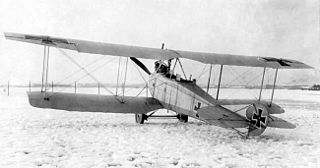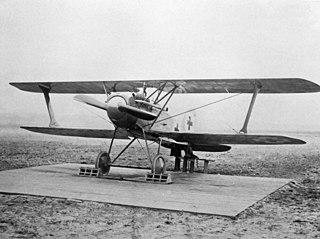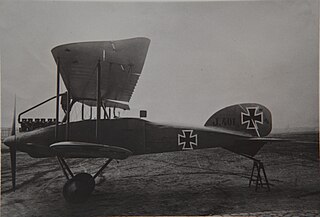The AEG DJ.I was a highly streamlined biplane ground attack aircraft of late World War I that was undergoing evaluation at the time of the Armistice.

The AEG J.I was a German biplane ground attack aircraft of 1917, an armored and more powerful version of the AEG C.IV reconnaissance aircraft.

The Aviatik C.I was an observation aircraft which came into service during World War I in April 1915. It was a development of the Aviatik B.I and B.II models, being one of first aircraft of the new German C class of armed biplanes. In the C.I the observer sat in front of the pilot, with a machine-gun clipped on a sliding mounting fitted on a rail at either side of the cockpit. It gave the crew the means to attack enemy aircraft. The positions of the pilot and observer were reversed in last series of 50, ordered in 1917 solely for trainer purpose. There was only one aircraft built of refined C.Ia version in May 1916, with armament still in a forward cab, serving as a prototype for C.III. Later models of the plane included the Aviatik C.II and the C.III, which had more powerful engines. The C.III was produced in large numbers.

The Albatros D.X was a German prototype single-seat fighter biplane developed in 1918 in parallel with the Albatros D.IXme

The Albatros J.I was a German armored ground attack airplane of World War I, produced in 1918.

The DFW C.IV, DFW C.V, DFW C.VI, and DFW F37 were a family of German reconnaissance aircraft first used in 1916 in World War I. They were conventionally configured biplanes with unequal-span unstaggered wings and seating for the pilot and observer in tandem, open cockpits. Like the DFW C.II before them, these aircraft seated the gunner to the rear and armed him with a machine gun on a ring mount. Compared to preceding B- and C-class designs by DFW, however, the aerodynamics of the fuselage were more refined, and when coupled with more powerful engines, resulted in a machine with excellent performance.

The Hansa Brandenburg W.27 and W.32 were prototype fighter floatplanes developed in parallel in Germany during World War I. They were developments of and intended replacements for the W.12 then in service and differed from each other principally in the choice of powerplant, the W.27 with a Benz Bz.IIIb and the W.32 with the same Mercedes D.III that the original W.12 used.

The Rumpler G.I was a bomber aircraft produced in Germany during World War I, together with refined versions known as the G.II and G.III.
The Aviatik D.III was a German prototype single-seater fighter plane from the First World War, designed by Aviatik. It became the basis for the Aviatik D.IV and Aviatik D.V. In November 1917, the plane was first flown, using a 195 hp Benz Bz IIIbo gearless engine. It was of similar design to the Aviatik D.II, and was armed with two LMG 08/15 machine guns. After several tests at Adlershof from February 9–12, 1918, the plane underwent modifications, as requested by the Idflieg. In April, a second prototype, powered by a Benz Bz IIIbm, although several D.III powered by the original IIIbo engine were already under production; however, none of them were ever completed.
The Aviatik D.VII was a German prototype single-seater fighter aircraft of the First World War, designed by Aviatik. Built to participate in the Third D-Type Contest of October 1918, it saw no military service. The only real major change from the D.VI was a completely new horizontal and vertical tail design.

The Zeppelin-Lindau CS.I was a German single-engined reconnaissance seaplane with a low-wing monoplane layout.
The Aviatik C.VIII was a prototype German observation aircraft built by Aviatik in World War I.
The Halberstadt C.III was a German single-engined reconnaissance biplane of World War I, built by Halberstädter Flugzeugwerke.

The Kondor D 2 was a German single seat, biplane fighter aircraft designed and built close to the end of World War I.
The Aviatik D.VI was a German prototype single-seater fighter aircraft of the First World War, designed by Aviatik.
The LVG C.VIII was a prototype reconnaissance aircraft built in Germany during World War I.

The LVG D.VI was a prototype German biplane fighter built by LVG in World War I.
The LFG Roland C.VIII was a German reconnaissance aircraft of World War I. It was manufactured by Luft-Fahrzeug-Gesellschaft G.m.b.H.
The Märkische D.I was a prototype single-seat fighter biplane built in the last months of World War I.
The Hansa-Brandenburg W.25 was a German floatplane fighter of the World War I era, designed and built by Hansa-Brandenburg.










